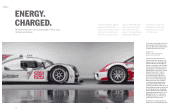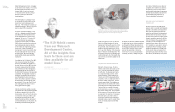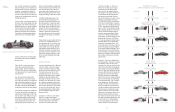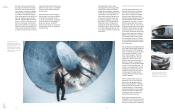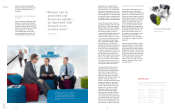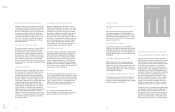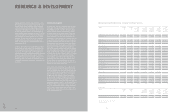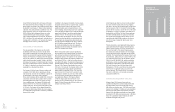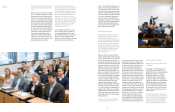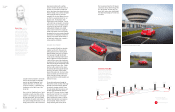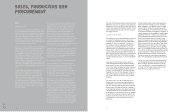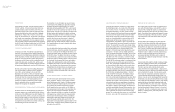Porsche 2014 Annual Report Download - page 30
Download and view the complete annual report
Please find page 30 of the 2014 Porsche annual report below. You can navigate through the pages in the report by either clicking on the pages listed below, or by using the keyword search tool below to find specific information within the annual report.
056 057
2012 20142013
Annual Report
Porsche AG
2014
As the nancial year drew to a close, Porsche unveiled
two more new GTS models at the 2014 Los Angeles
Auto Show – the 911 Carrera GTS and the Cayenne GTS.
The four variants of the 911 Carrera GTS close the gap
between the 911 Carrera S and the 911 GT3. The model
is available as a coupé or convertible, each with rear or
all-wheel drive and 430 hp. The Sport Chrono package
and other markedly athletic trim options are standard.
The Cayenne GTS generates 440 hp and has an even
more athletically tuned PASM suspension; the chassis
sits 24mm lower, making the vehicle even more
aerodynamic.
Porsche presented an even higher-performing Cayenne
model at the 2015 North American International Auto
Show in Detroit in January 2015: the Cayenne Turbo S.
The new “top model” of the newest Cayenne genera-
tion stands out in particular thanks to its new charging
concept with turbochargers integrated into the exhaust
manifolds. This feature pushes the Cayenne Turbo S past
its predecessor, adding 20 hp for a total of 570 hp. The
car’s maximum torque, which was increased by 50 Nm
(36.8 ft lb) to 800 Nm (590 ft lb), enables superlative
performance, and the new turbochargers have further
improved the responsiveness of the twin-turbo engine.
The Turbo S turned a lap of the North Loop of the
Nürburgring in 7:59.74, a new SUV record, proving that
every Porsche is a genuine sports car, even in this
vehicle segment. The Cayenne Turbo S accelerates
from zero to 100km/h in 4.1 seconds and reaches
a top speed of 284km/h.
RESEARCH AND DEVELOPMENT COSTS RISE
In nancial year 2014, research costs and non-
capitalised development costs (excluding amortisation
and depreciation) of the PorscheAG group came to
886million euro (previous year: 762 million euro). Deve-
lopment costs totalling 1.07 billion euro were capitalised
(previous year: 815 million euro). Research and deve-
lopment costs (excluding amortisation and depreciation)
amounted to 1.95 billion euro (previous year: 1.58 billion
euro). The capitalisation ratio in nancial year 2014
remained unchanged at 55percent.
In April 2014, the Boxster GTS and Cayman GTS made
their début at the Auto China in Beijing. The six-cylinder
Boxer engines are based on the 3.4-litre drivetrains from
the Boxster S and Cayman S. Thanks to their optimised
calibration, they each generate an additional 15 hp. This
brings the Boxster GTS up to 330 hp and the Cayman
GTS to 340 hp. Both mid-engined sports cars come
standard with the Sport Chrono package. Equipped
with an optional double-clutch transmission, the Boxster
GTS – with Sport Plus mode activated – catapults from a
standing start to 100km/h in 4.7 seconds; the Cayman
GTS edges out its cousin by a tenth of a second.
NEW CAYENNE IN THE SPOTLIGHT
The new generation of the Cayenne was the centre
of attention at the Paris auto show in October 2014.
The Cayenne S E-Hybrid was also the rst-ever plug-in
hybrid in the premium SUV segment. With the Cayenne S
E-Hybrid, the Panamera S E-Hybrid and the 918 Spyder,
Porsche was now the only brand in the premium segment
which oered three plug-in models. Thanks to its hybrid
technology, the Cayenne S E-Hybrid boasts fuel consump-
tion of just 3.4litres/100km and CO2 emissions of mere-
ly 79 g/km. In absolute terms, these are top numbers,
especially for an all-wheel drive vehicle.
The Cayenne S E-Hybrid uses a lithium ion battery with
a capacity of 10.8 kWh, which, depending on driving
style and terrain, provides for an all-electric range of 18
to 36 kilometres. The electric motor generates
95 hp, which combines with the output of the 3.0-litre V6
compressor motor (333 hp) to produce 416 hp in total.
The driving performance falls in the sports car range.
From a standing start, the Cayenne S E-Hybrid accel-
erates to 100km/h in 5.9 seconds and boasts a top
speed of 243km/h. The top speed of the electric motor
is 125km/h. The battery can be charged through the
power grid or while driving. Vehicle data can be viewed
on a smartphone using Porsche Car Connect, a standard
feature for this series.
In addition to the Cayenne S E-Hybrid, Porsche present-
ed updates to the Cayenne S, Cayenne Turbo, Cayenne
Diesel and Cayenne S Diesel. The vehicles’ most
signicant features were increased eciency, more
precise handling, sharper design and more comprehen-
sive series tting. In addition, the 3.6-litre V6 twin-turbo
engine in the Cayenne S was all new and developed
solely by Porsche. The front apron, front mud aps
and bonnet were all redesigned. The rear of the new
Cayenne has also been given a completely new look:
The rear lights are arranged three-dimensionally and
the brake lights are divided into four parts, similar to
the LED daytime running lights up front. The licence
tub, handle and lighting have been more elegantly
integrated into the rear hatch. An automatic hatch is
part of the standard series tting.
All the new Cayenne models consume signicantly
less fuel thanks to the coasting function, an improved
auto start-stop function and an optimised thermal
management system. The Cayenne S’s new 3.6-litre V6
twin-turbo engine achieves fuel eciency between 9.5
and 9.8litres/100km – a full litre less than the previ-
ously oered V8 engine. The twin-turbo V6 generates a
maximum output of 420 hp. With its standard 8-speed
Tiptronic S, the Cayenne S accelerates from zero to
100km/h in 5.5 seconds. The Cayenne Turbo’s 4.8li-
tres of displacement, eight cylinders and twin-turbo
engine enable it to generate 520 hp. The Turbo thus
goes from zero to 100km/h in 4.5 seconds. Its fuel
consumption is between 11.2 and 11.5litres/100km.
The diesel variants combine high performance with
even higher fuel eciency. The Cayenne Diesel’s
3.0-litre V6 engine generates 262 hp with a fuel
eciency of 6.6 to 6.8litres/100km. The CayenneS
Diesel’s 4.2-litre V8 engine has 385 hp. Its fuel con-
sumption is 8.0litres/100km.
Research & Development
RESEARCH AND
DEVELOPMENT COSTS
IN BILLION EURO
1.31
1.58
1.95


